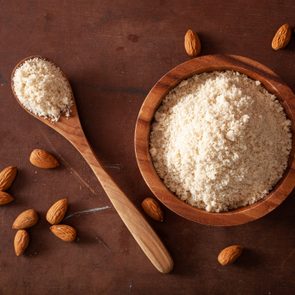7 Health Benefits of Almonds
Updated: Nov. 30, 2020
Almonds pack a powerful nutritional punch in a small package. Eating almonds may help lower your risk for heart disease, keep your weight down, and offer other health benefits.
Everyone is going nuts for almonds. From almond milk and almond flour to almond cheeses and other almond-based foods, almonds are the “it” nut. But just what is it that’s so special about this tree nut that hails from the Mediterranean?
Lots, says Kristi Crowe-White, PhD, RD, associate professor and department chair in the Department of Human Nutrition and Hospitality Management at the University of Alabama. “Almonds are a fantastic superfood and contain over 10 macronutrients and micronutrients that are essential to bolstering cardiovascular health,” says Crowe-White, also an Institute of Food Technologists member expert. That’s why they’re among the five healthiest nuts to eat.
Almonds are also tasty and come in many flavors such as cocoa-dusted, BBQ, wasabi, and sea salt, which is another reason for almonds’ soaring popularity. The average American eats about two pounds of almonds per year. That number has been increasing steadily, according to the Agricultural Marketing Resource Center, a group funded by the United States Department of Agriculture (USDA).
What are almonds and where do they come from?
Almonds are wrapped in a tough, leathery hull and an inner, protective hard shell. They are harvested by being shaken off a tree and sent to be roasted, blanched, or processed in another way. Then they are marketed and sold in a multitude of varieties, including whole, sliced, chopped, and slivered. Not much goes to waste. The excess hull and shell are used for food and bedding material for the livestock industry.
The majority of almonds in the United States are consumed as ingredients in cereal, granola bars, bites, and other baked goods. The rest are eaten as snacks, used in at-home baking, and/or sold at food-service outlets. California is the only state that produces almonds commercially—and business is booming. The USDA predicts that California will produce three billion pounds of almonds in 2020. That’s an increase of 17.6 percent from 2019.

Health benefits of almonds
From healthy fats to loads of vitamins and nutrients, these tasty nuts offer a range of health benefits. Here are some almond nutrition facts you should know.
Healthy fats
Almonds are rich in heart-healthy monounsaturated fats, says Crowe-White. “The Western diet is heavy in saturated fat, which leads to plaque buildup in arteries,” she says. This sets the stage for heart disease.
“Replacing saturated fat with monounsaturated or other healthy fats can lower heart disease risk,” she says. “One ounce, or 24 almonds, has 14 grams of fat, and 80 percent of it is monounsaturated.” No wonder almonds have heart-healthy certification and are certified with The American Heart Association Heart-Check mark.
A review of studies, published in a 2019 issue of Advances in Nutrition, looked at how almonds affect heart health and found that almonds reduce “bad” low-density lipoprotein (LDL) cholesterol, total cholesterol, body weight, and apolipoprotein B, which transports bad cholesterol throughout the body.
Vitamin E
One ounce of almonds provides about 7 milligrams of vitamin E, which is about half of what you need each day.
“Almonds are one of the best sources of vitamin E,” Crowe-White says. A potent antioxidant, vitamin E sops up damaging free radicals that can increase risk for heart disease and other conditions. “Much of the acclaim about almonds is about their antioxidant profile, and vitamin E is the most abundant antioxidant in almonds,” she says.
Magnesium
An ounce of almonds contains close to 80 milligrams of magnesium—about 20-25 percent of what you need each day. This mineral is important for maintaining healthy blood pressure levels. High blood pressure is a major risk factor for heart attack and stroke.
But there’s a caveat when it comes to almonds and blood pressure, says Lauri Y. Wright, PhD, RDN, nutrition and dietetics associate professor at the University of North Florida. Many almond varieties have added salt, and salt may increase blood pressure levels. “Au natural is the best way to go,” she says. Or choose low-salt or reduced-sodium almonds.
Calcium
When you think of calcium, your mind likely goes to milk and other dairy foods—but don’t count out almonds. An ounce of almonds has about 76 milligrams of calcium, which works with vitamin D to build bones.
Fiber
Just one ounce of nuts packs 3.5 grams of fiber. Fiber keeps you feeling full longer, keeps bowel movements regular, and can help lower blood cholesterol levels, among other health benefits, says Wright, also a spokesperson for the Academy of Nutrition and Dietetics.
Most Americans don’t get near the fiber they need. The recommended amount of dietary fiber is about 25 grams for women and 38 grams for men each day. Almonds can add to the total and you can sneak them into your diet. “Almonds makes a wonderful snack,” Wright says. “They are a nice addition to salads and they really do pack a mighty punch.”
Protein
An ounce of almonds contains 6 grams of protein. Protein needs vary by age and health status, says Crowe-White. Without adequate protein in your diet, your body can’t build and repair muscle, skin, and other bodily tissues.
Meaningful calories
Almonds have calories—roughly 165 per ounce—and this needs to be considered if you are trying to lose weight. “An almond’s calories are meaningful, not empty. Almonds are nutrient-dense for their portion size,” Crowe-White says. “You get so much more bang for your buck.”
It’s important to watch out for added sugar, but that doesn’t mean to avoid sweetened almonds, she says. “Chocolate-dusted almonds may only have 1-2 more grams of sugar than regular almonds,” she says. This is likely better and healthier than another snack that might satisfy your sweet tooth, “This is a negligible amount of sugar,” she adds. “So if it helps you get over a midday food crisis, that’s alright.”





















